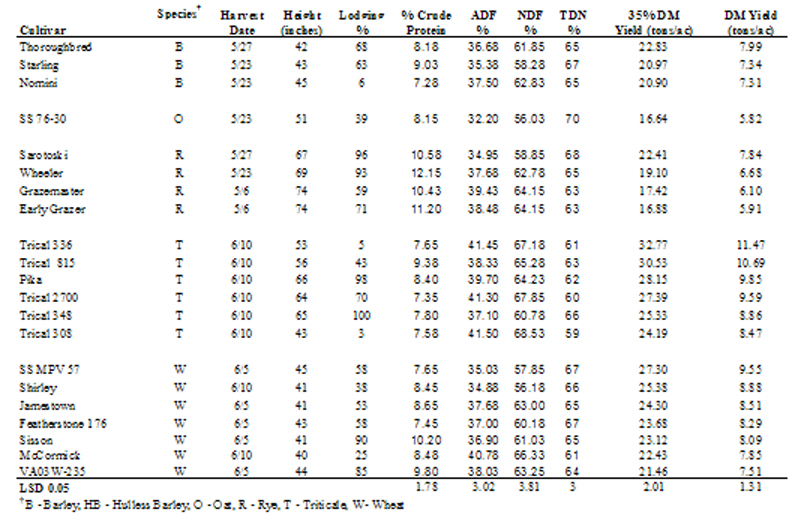
You've reached the Virginia Cooperative Extension Newsletter Archive. These files cover more than ten years of newsletters posted on our old website (through April/May 2009), and are provided for historical purposes only. As such, they may contain out-of-date references and broken links.
To see our latest newsletters and current information, visit our website at http://www.ext.vt.edu/news/.
Newsletter Archive index: http://sites.ext.vt.edu/newsletter-archive/

Crop and Soil Environmental News, November 2009
Authors: Dave Starner, Superintendent Northern Piedmont AREC, Steve Gulick, Research Specialist, Northern Piedmont AREC, Alvin Hood, Technician, Northern Piedmont AREC and Wade Thomason, Extension Grains Specialist

A forage production trial of commercial barley, oat, rye, triticale, and wheat cultivars has been conducted yearly from 1994-2008 at the Northern Piedmont AREC, Orange. Long-term results were published in 2004 and are available on the web at http://www.ext.vt.edu/pubs/forage/418-019/418-019.pdf.
This report presents the results and precipitation from this trial in the 2007-08 growing season.
Preplant fertilizer of 25-64-22-22S was applied on September 27, 2007. Plots were planted on Oct. 16, 2007 and were seven, seven inch rows wide by 16 feet long, trimmed to 12 feet for harvest. Plots emerged on November 7. Tillers were counted and ground cover was estimated on March 7, 2008. Nitrogen as UAN at a rate of 60 lb of N per acre was applied on March 3, 2008. The plots were harvested for forage yield at the boot (GS 45) and soft dough (GS 85) stages for barley, oats, triticale, and wheat and at the boot and flowering stages for rye. The entire length of the plots (12 feet) was harvested with a 12-inch Jari sickle-bar mower and weighed with an electronic hanging scale.
Figure 1. Long term mean and 2008 growing season statewide rainfall.
Fall of 2007 presented challenging planting conditions for many growers due to dry soil conditions with over half the state reported to be very short of soil moisture. Growers needing to perform primary tillage waited for rain while some small grain was planted into these dry seedbeds. Rains in late October improved conditions dramatically and by the end of the first week of November, wheat planting reached 53 percent of intended acres, which is the same as the five year average. Early winter was relatively dry and while there were still concerns over subsoil moisture, most of the small grain crop was rated good or better. Warm and favorable conditions in April resulted in wheat heading approximately 5 days earlier than the long term average.
Results are reported for 35 percent dry matter (DM), DM yield, and nutritive value for oats, wheat, barley, rye, and triticale crops.
Experimental plots vary in yield and other measurements due to their location in the field and other factors which cannot be controlled. The statistics given in the tables are intended to help the reader make valid comparisons between cultivars. The magnitude of differences which may have been due to experimental error has been computed for the data and listed at the bottom of columns as the LSD (.05) (least significant difference with 95 percent confidence). Differences must be greater that the LSD to be believed to truly exist.
Table 1. Small Grain Forage Variety Test, Northern Piedmont AREC, Orange, Va 2007-2008, Boot Stage Harvest

Table 2. Small Grain Forage Variety Test, Northern Piedmont AREC, Orange, Va 2007-2008, Soft Dough Stage Harvest


Visit Virginia Cooperative Extension